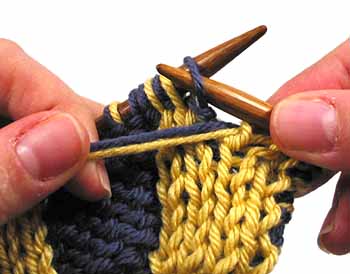The position of the working yarn is crucial for double-knitting: This is the single-most important skill to master for the technique. As you knit a row, you will be knitting a stitch from one side of the fabric and then from the opposite side: in doing so you will most likely be changing the position of the working yarn with each stitch.
As you are learning and becoming comfortable with double-knitting, make sure to check BOTH sides of your work after you complete each row. It is a very common mistake while learning this technique to inadvertently carry the yarn in front of the stitches on the opposite side of the fabric or to knit when you should purl (or vice versa). See our tutorial on correcting errors for tips on how to correct this without having to rip up your work!
Notice that the swatch below features a vertically-striped knitted fabric. On each side of the double-knit fabric, the stripes alternate with knitted stripes in one color, then purl stripes of the opposite color. The facing yarn is the yarn of the stitch that is on the fabric facing you, the opposite yarn is the yarn of the stitch of the fabric opposite you.
|
|
Knitting a stitch of the fabric FACING you:
- Note: In this example, the facing yarn is yellow and the opposite yarn is purple.
- Hold both the facing and the opposite yarn to the BACK of the work.
- Insert the needle knitwise into the next stitch and yarn over with the facing yarn to knit the next stitch.
|
|
|
Purling a stitch of the fabric FACING you:
- Note: In this example, the facing yarn is purple and the opposite yarn is yellow.
- Hold the facing yarn to the FRONT of the work and the opposite yarn to the BACK of the work.
- Insert needle purlwise into the next stitch and yarn over with the facing yarn to purl the next stitch.
|
|
|
Knitting a stitch of the fabric OPPOSITE you:
- Note: In this example, the facing yarn is purple and the opposite yarn is yellow.
- Note: Keep in mind while working the opposite fabric that you are working with the WS of the fabric facing you. In other words, when you knit a stitch on the opposite fabric, you will see the purl side of the stitch on the RS of the fabric when you turn your work around.
- Hold the facing yarn to the FRONT of the work and the opposite yarn to the BACK of the work.
- Insert needle knitwise into the next stitch and yarn over with the opposite yarn to knit the next stitch.
|
|
|
Purling a stitch of the fabric OPPOSITE you:
- Note: In this example, the facing yarn is yellow and the opposite yarn is purple.
- Note: Keep in mind while working the opposite fabric that you are working with the WS of the fabric facing you. In other words, when you purl a stitch on the opposite fabric, you will see the knit side of the stitch on the RS of the fabric when you turn your work around.
- Hold both the facing and the opposite yarn to the FRONT of the work.
- Insert the needle purlwise into the next stitch and yarn over with the opposite yarn to purl the next stitch.
|




